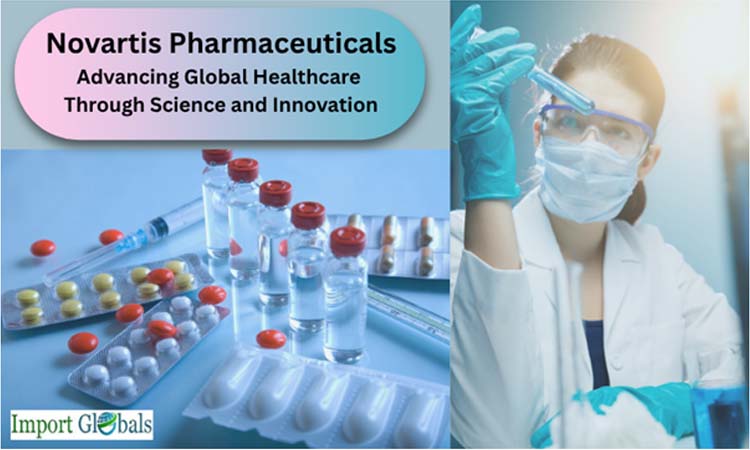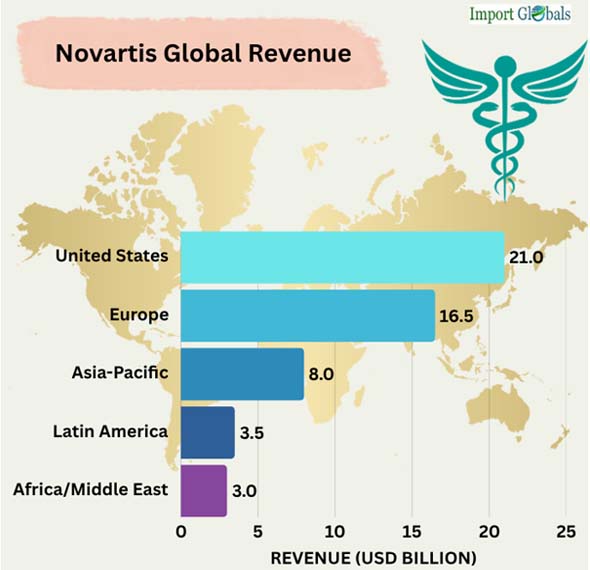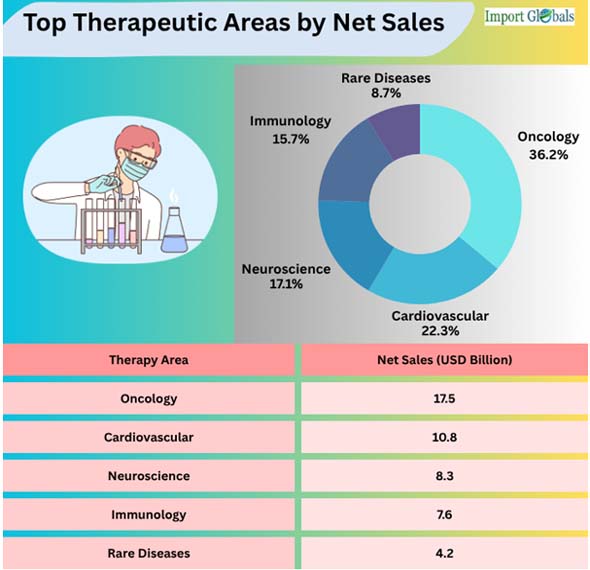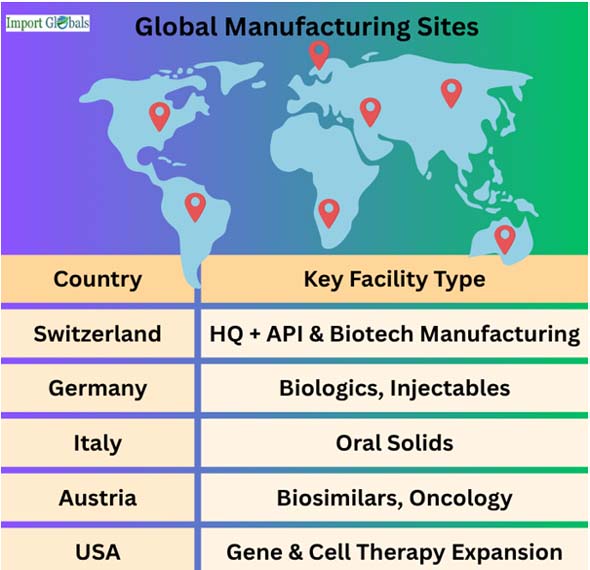
- Oct 15, 2025
Novartis Pharmaceuticals: Advancing Global Healthcare Through Science and Innovation
In the global healthcare ecosystem, Novartis, a multinational pharmaceutical company based in Switzerland, is a symbol of innovation, accessibility, and scientific brilliance.
Based on Global Import Data by Import Globals, with operations in more than 150 nations and a line of products that tackle some of the most urgent medical issues, Novartis is essential to the advancement of medical research and the provision of life-saving therapies to patients everywhere.
Novartis Legacy: Combining Vision and Science
Novartis was established in 1996 as a result of the combination of Ciba-Geigy and Sandoz, two well-known Swiss corporations. Its headquarters are in Basel, Switzerland. Based on Switzerland Export Data by Import Globals, the firm has dedicated itself to providing high-quality, reasonably priced medications supported by state-of-the-art research and innovation since its founding. Today, Novartis treats more than 300 million patients a year and has over 75,000 employees worldwide.
In 2023, the corporation spun off its generics division, Sandoz, after methodically realigning throughout the years to concentrate only on branded prescription medications. Novartis wants to become a "pure-play innovative medicines" firm that leads therapeutic advances in cardiovascular diseases, immunology, hematology, neurology, and cancer. This change represents their goal.

Top-Performing Drugs
In addition to controlling the market, Novartis' extensive line of high-impact medications has revolutionized the way that many chronic and life-threatening illnesses are treated.
Entresto
Entresto is a ground-breaking medication for heart failure that combines valsartan and sacubitril. As per Novartis Import Export Trade Data by Import Globals, it has grown rapidly in recent years; in 2024, sales will have surpassed $7.8 billion, a 31% rise from the year before. The global standard of care for people with heart failure has been altered by this medication.
Cosentyx
One of Novartis's best-selling immunology medications is Cosentyx, which is used to treat psoriasis, psoriatic arthritis, and ankylosing spondylitis. Despite producing $1.63 billion in Q2 2025, a little less than the $1.75 billion predicted, it is still a key component of the company's therapeutic line for autoimmune diseases.
Kisqali
Novartis' top oncology medication, Kisqali, targets advanced or metastatic HR+/HER2-positive breast cancer. It is still one of the cancer treatments that doctors trust the most and continues to demonstrate significant therapeutic effects.
The Kesimpta
As per Novartis Import Custom Data by Import Globals, this medication represents a significant advancement in the management of multiple sclerosis (MS). In the market for autoimmune treatments, its once-monthly injections administered at home have made it particularly appealing.
Leqvio
With only two maintenance doses required annually, Leqvio is the first and only small interfering RNA (siRNA) medication authorized for decreasing LDL cholesterol. It's a crucial component of Novartis's attempts to combat cardiovascular illness, and its approval and international launch have given it a boost.
Investing in R&D

The foundation of Novartis' success is innovation. Based on World Import Trade Analysis by Import Globals, the business spent more than $9 billion on research and development in 2024, which accounted for more than 17% of its total sales. With over 160 projects, many of which are undergoing Phase II or Phase III clinical trials, this dedication has produced a rich pipeline.
Among the noteworthy innovations are:
DFV890: A new inhibitor of the NLRP3 inflammasome for myeloid and inflammatory disorders.
Platforms for gene Therapy: Particularly for neuromuscular and ophthalmological conditions.
Based on Novartis Export Data by Import Globals, partnerships for antisense and siRNA-based medications that target diseases that were previously untreatable are examples of RNA-based treatments.
With this pipeline, Novartis is guaranteed to maintain its position as a global leader in therapeutic innovation for high-burden, high-cost illnesses.
Investing in R&D
The foundation of Novartis' success is innovation. The business spent more than $9 billion on research and development in 2024, which accounted for more than 17% of its total sales. As per Novartis Import Data by Import Globals, with over 160 projects, many of which are undergoing Phase II or Phase III clinical trials, this dedication has produced a rich pipeline.
Strategic Partnerships and Purchases
In recent years, Novartis has made several well-known partnerships and acquisitions to keep its creative edge:
2024: MorphoSys AG. This $2.7 billion acquisition increased Novartis's pipeline for cancer and hematology.
Chinook Therapeutics: Based on Novartis Import Trade Statistics by Import Globals, acquired for around $3.2 billion to bolster its emphasis on nephrology.
Anthos Therapeutics: A $925 million agreement to strengthen its capacity to develop cardiovascular drugs.
Matchpoint Therapeutics (2025): This $1 billion partnership will use cutting-edge protein degrader technology to develop oral treatments for inflammatory and autoimmune illnesses.
As per Novartis Import Shipment Data, these deals represent Novartis’s strategic expansion into promising biotech spaces with future-ready therapeutic platforms.
Worldwide Production and Distribution System

Novartis's extensive worldwide distribution network enables its medications to reach patients in both developed and developing nations. As per Asia Import Export Trade Analysis by Import Globals, the business runs state-of-the-art manufacturing plants across Asia, Europe, and the United States.
Novartis revealed a $23 billion investment plan in 2025 to develop and construct ten cutting-edge manufacturing facilities in the US. The company's objective of guaranteeing quick, scalable access to essential medications worldwide and protecting supply chain resilience is in line with this expansion.
Medicine Access and Social Effects
The goal of Novartis goes beyond financial prosperity. The business has a strong commitment to affordability and health equity. Through the Novartis Access program, low-income communities can obtain necessary diabetic and cardiovascular medications for as little as $1 per treatment per month.
Novartis also created Coartem Baby, the first malaria medication authorized especially for newborns weighing less than two kilos. This formulation, which has been approved by Swissmedic, is being supplied to several African nations on a non-profit basis to fight childhood malaria. In India, based on India Export Import Global Trade Data by Import Globals, Novartis launched flexible payment options for its cholesterol-lowering drug Inclisiran (Sybrava) to support patient affordability in a price-sensitive market. This is part of a broader strategy to deepen Novartis’s roots in emerging economies by offering affordable innovation.
India's Novartis: A Center for Innovation and Development
Through its two companies, Novartis India Limited (which is publicly traded) and Novartis Healthcare Pvt Ltd (which is completely owned), Novartis has a long history in India. Operating out of Hyderabad, a worldwide service hub for drug research, clinical trials, data analytics, and digital innovation, the organization has over 8,100 employees nationwide.
A strategic review of Novartis India Limited to investigate operational efficiencies was announced by Novartis in February 2024. Its expansion ambitions and wider activities in India are unaffected by this, though.
Conclusion
Through 2025, Novartis aims to achieve a low double-digit increase in core operating income. It is at the vanguard of pharmaceutical innovation worldwide thanks to its investments in sophisticated biologics and RNA-based medications, dedication to research and development, and intensified emphasis on high-growth therapeutic areas.
Novartis is positioned to have an even greater impact on the direction of medicine with the introduction of next-generation therapies, growth in developing nations, and patient-first affordability models. Import Globals is a leading data provider of Novartis import export trade data. Subscribe to Import Globals to get more global trade details!
FAQs
Que. What is Novartis best known for?
Ans. Novartis is renowned for its innovative pharmaceuticals, particularly in cardiology, oncology, immunology, and neuroscience, with drugs like Entresto, Cosentyx, Kisqali, and Kesimpta.
Que. How does Novartis ensure medicine affordability in poor countries?
Ans. Through initiatives like Novartis Access and special not-for-profit distribution models (e.g., Coartem Baby for malaria), the company ensures low-cost access to essential medicines.
Que. What makes Novartis’s R&D unique?
Ans. The company invests heavily in cutting-edge therapies such as gene and RNA-based treatments, and has over 160 ongoing clinical projects across multiple diseases.
Que. Is Novartis active in India?
Ans. Yes, Novartis operates major R&D, manufacturing, and digital innovation centers in India, employing thousands and supporting numerous clinical research activities.
Que. Where can you obtain detailed Novartis Import Export Global Data?
Ans. Visit www.importglobals.com or email info@importglobals.com for more information on up-to-date data.
